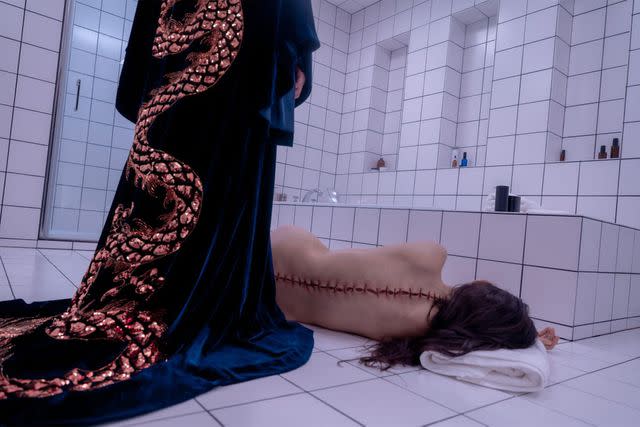“The Substance” is a piercing indictment of society's attitude toward women's aging told via body horror

Demi Moore and Margaret Qualley go all in on the bonkers material.
The Substance, which won Best Screenplay at Cannes and is now playing at the Toronto International Film Festival, is a grotesque parable about the lengths women will go to pursue youth and beauty. Written and directed by Coralie Fargeat (Revenge), the film is also a brilliant excoriation of double standards and a portrait of obsession... that I never want to endure watching again (and I mean that as a compliment).
It's provocative, certainly, but the visceral fantasia of blood and gore effectively captures the contradictions between Hollywood's golden image and sordid underbelly. Elisabeth Sparkle (Demi Moore), a movie character name for the ages, was once a coveted and adored star. From her place on the Walk of Fame to her hit fitness show, she embodied the portrait of health and wellness (which is politically correct speak for young and beautiful). On the day of her 50th birthday, she is summarily dismissed by her cartoonishly chauvinistic boss, Harvey (Dennis Quaid) — and yes, that first name is intentional. Quaid gives a performance so smug that it makes my skin crawl while also leaving me to ponder if the conservative actor is in on the joke or not.
Depressed and suffering from career-induced body dysmorphia, Elisabeth decides to try a black-market drug known as the Substance, which promises a younger, better version of herself. That turns out to be literal as Sue (Margaret Qualley) is birthed from the fluid and viscera of Elisabeth's spine.

Courtesy Cannes Film Festival
Demi Moore in 'The Substance'Despite repeated warnings that Elisabeth and Sue must swap consciousness every seven days, she becomes increasingly reluctant to give up the adulation she receives as a perky, nubile television sensation. Even when it becomes clear that her extended stays in her clone's body are causing her own to decay at an alarming rate, she can't shake her addiction to the feeling of being Sue.
There is nothing subtle about The Substance. From its use of camera angles and extreme close-ups to frame Sue's hypersexual appeal to the heinous prosthetics that transform Moore into a monstrous crone, writer-director Coralie Fargeat wants to hammer home the ugliness, objectification, and self-loathing perpetuated by female beauty standards. The film is a true work of body horror with bulging skin, creaking bones, pestilent fluids, and buckets of blood, literalizing the monstrous cost of remaining desirable.
Related: Demi Moore's 'gory as hell,' 'f---ing insane' body horror movie gets huge standing ovation at Cannes
Moore and Qualley give truly unhinged performances. Moore goes for broke as Elisabeth rapidly ages, flawlessly executing a sequence during which the haggard former star mocks one of Sue's television interviews. It's horrifying and hilarious in equal measure.
Qualley employs her ample beauty to infantilize Sue, biting her lip suggestively and thrusting her pelvis while maintaining an insouciant innocence. But she is not innocent so much as she is Elisabeth's Id, making choices purely driven by her own desire and need to be desired. Both women give intense physical performances, bearing their naked forms to contrast Elisabeth's mature body with Sue's supple skin. They throw themselves into a feral posture and perpetual state of attack, scrabbling for their piece of public adoration as they stalk each other like jungle cats circling their prey.

Courtesy Cannes Film Festival
Demi Moore in 'The Substance'Fargeat also includes direct nods to other tales of horror and obsession. The carpet in the television studio hallway and its ominously high walls recreate those of The Shining's Overlook Hotel, and later, the theme from Vertigo plays during a scene in which Elisabeth/Sue strives to transform into a vision of what they yearn to be most — someone young and beautiful. Again, these references are far from subtle, but they're effective all the same.
Want more movie news? Sign up for Entertainment Weekly's free newsletter to get the latest trailers, celebrity interviews, film reviews, and more.
Without giving away too much, the film's third act descends into a cacophony of chaos, monstrosity, and blood. It pushes the boundaries of its storytelling to the brink (and leaps over the limits of tastefulness in a single bound). While it is so over-the-top as to verge on camp, it is also a chillingly pointed expression of the madness that ensues in pursuit of impossible standards — and the self-loathing and hatred that emerges when women are pitted against each other and themselves. Be warned, the film is not for the faint of heart with its oozing body cavities, slithering viscera, and firehose blasts of blood. At any given moment, I found myself thinking that it was the craziest thing I had ever seen.
The Substance is about a deadly drug, but its most toxic feature is how it reinforces a bootless need for external validation. The film's final image speaks to the horrific lengths women will go to for a taste of the admiration they crave — only to be power-washed from cultural relevancy in an instant. Grade: B+
Read the original article on Entertainment Weekly.

 Yahoo Lifestyle
Yahoo Lifestyle 
